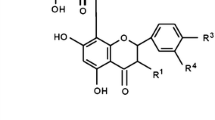Antioxidant activity of a pharmaceutical substance hypocard was compared with activity of nitromalic acid and well-known agents nicorandil and Mexidol. The ability of these substances to inhibit spontaneous and oxidant-induced LPO process in rat brain homogenate was analyzed. The mechanisms of these effects were studied. The antioxidant properties of hypocard manifested in the inhibition of Fe(II)-induced LPO were significantly more pronounced in comparison with Mexidol and nicorandil.
Similar content being viewed by others
References
Vasenina EE, Levin OS. Oxidizing stress in patogeneza of neurodegenerate diseases: possibilities of therapy. Sovremen. Ter. Psikhiatr. Nevrol. 2013;(3-4):39-46. Russian.
Klebanov GI, Lyubitsky OB, Vasiljeva OV, Klimov YuA, Penzulaeva OB, Teplyashin AS, Tolstyh MP, Promorenko VK, Vladimirov YuA. Antioxidant properties of analogues of 3-oxypyridine: Mexidol, emoxipin, proxipin. Vopr. Med. Khimii. 2001;47(3):288-300. Russian.
Kosolapov VA, Spasov AA, Anisimova VA. Study of antiradicalactivity of new compounds by chemiluminescence. Biomed. Khimiya. 2005;51(3):287-294. Russian.
Lankin VZ, Tikhaze AK, Belenkov YuN. Free radical processes in diseases of the cardiovascular system. Kardiologiya. 2000;40(7):48-61. Russian.
Tat’yanenko LV, Dobrokhotova OV, Varfolomeev VN, Fadeev MA, Fedorov BS, Shtol’ko VN, Mishchenko DV. Effect of Mexidol and NitroxyMexidol on Phosphodiesterase Activity, Some Oxidation Processes, and Hypoxia Resistance. Pharm. Chem. J. 2014;48(7):417-420.
Shilov AM. Antihypoxants and antioxidants in the treatment of coronary heart disease. Arkh. Vnutr. Med. 2013;(4):41-50. Russian.
Sokolova MG, Lobzin SV, Nikishina OA, Kiselev AV, Rezvantsev MV, Litvinenko IV, Gavrichenko AV. Pathogenesis of cognitive disorders in patients with Duchenne muscular dystrophy. Zh. Nevrol. Psikhiatr. 2017;117(12):78-86. Russian.
Afzal MZ, Reiter M, Gastonguay C, McGivern JV, Guan X, Ge ZD, Mack DL, Childers MK, Ebert AD, Strande JL. Nicorandil, a nitric oxide donor and ATP-sensitive potassium channel opener, protects against dystrophin-deficient cardiomyopathy. J. Cardiovasc. Pharmacol. Ther. 2016;21(6):549-562.
Barbato E, Herman A, Benit E, Janssens L, Lalmand J, Hoffer E, Chenu P, Guédès A, Missault L, Pirenne B, Cardinal F, Vercauteren S, Wijns W. Long-term effect of molsidomine, a direct nitric oxide donor, as an add-on treatment, on endothelial dysfunction in patients with stable angina pectoris undergoing percutaneous coronary intervention: results of the MEDCOR trial. Atherosclerosis. 2015;240(2):351-354.
Brand-Williams W, Cuvelier ME, Berset C. Use of a free radical method to evaluate antioxidant activity. Lebenson Wiss. Technol. 1995;28:25-30.
Eremenko LT, Nesterenko DA, Garanin VA, Kosilko VP. Development of improved laboratory technique for nicorandil synthesis. Russ. J. Appl. Chem. 2009;82(10):1776-1779.
Gülçin I, Mshvildadze V, Gepdiremen A, Elias R. Screening of antiradical and antioxidant activity of monodesmosides and crude extract from Leontice smirnowii tuber. Phytomedicine. 2006;13(5):343-351.
Mishchenko DV, Neganova ME, Klimanova EN, Sashenkova TE, Shevtsova EF, Vystorop IV, Tarasov VV, Ashraf GM, Yarla NS, Aliev G. Chemosensitizing activity of histone deacetylases inhibitory cyclic hydroxamic acids for combination chemotherapy of lymphatic leukemia. Curr. Cancer Drug Targets. 2017. Jun 23. doi: https://doi.org/10.2174/1568009617666170623104030.
Serafim RA, Primi MC, Trossini GH, Ferreira EI. Nitric oxide: state of the art in drug design. Curr. Med. Chem. 2012; 19(3):386-405.
Zamotaeva MN, Chairkin IN, Inchina VI, Drozdov IA. Experimental substantiation for the use of Mexidol and 3-hydroxypyridine fumarate in chronic myocardial injury. Bull. Exp. Biol. Med. 2013;155(2):212-213.
Author information
Authors and Affiliations
Corresponding author
Additional information
Translated from Byulleten’ Eksperimental’noi Biologii i Meditsiny, Vol. 166, No. 7, pp. 53-57, July, 2018
Rights and permissions
About this article
Cite this article
Neganova, M.E., Klochkov, S.G., Shevtsova, E.F. et al. Antioxidant Properties of a Pharmaceutical Substance Hypocard, a Potential Drug for Ischemic Disease. Bull Exp Biol Med 166, 46–49 (2018). https://doi.org/10.1007/s10517-018-4286-4
Received:
Published:
Issue Date:
DOI: https://doi.org/10.1007/s10517-018-4286-4




